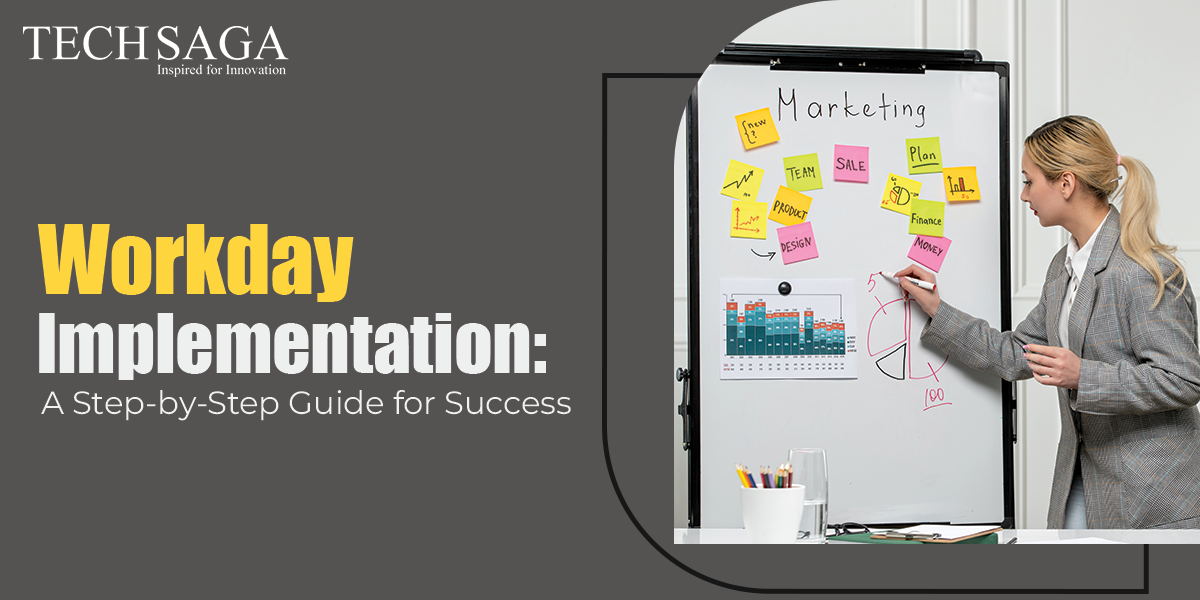Techsaga USA
Get valuable insights and stay updated on our interesting Techsaga US blog. We are experts in the world of IT consulting and IT support.
Workday Implementation: A Step-by-Step Guide for Success
Workday is a cloud-based enterprise resource planning (ERP) software that helps organizations manage their human resources (HR), finance, and planning processes. With its powerful suite of applications, the implementation of Workday has become a go-to solution for businesses aiming to streamline operations, improve decision-making, and enhance data visibility.
However, successful Workday implementation requires careful planning, a structured approach, and a dedicated team. In this article, we’ll guide you through a step-by-step process to ensure the successful implementation of Workday in your organization.
What is Workday?
Before diving into the implementation process, it’s essential to understand what Workday offers. Workday provides a unified system that integrates various business functions, including:
- Human Resources Management: Payroll, talent management, recruitment, benefits administration, and employee self-service.
- Financial Management: Accounting, financial reporting, procurement, and expense management.
- Planning and Analytics: Budgeting, forecasting, and real-time data insights for better decision-making.
By centralizing these functions into one system, Workday enhances operational efficiency and provides a comprehensive view of your organization’s performance.
Why is Workday Implementation Crucial?
A successful Workday implementation provides several key benefits to businesses, such as:
- Improved Operational Efficiency: Streamline HR and financial processes by automating workflows and reducing manual tasks.
- Real-Time Data Analytics: Make data-driven decisions with real-time reporting and insights.
- Better Employee Experience: Offer employees an easy-to-use platform for managing their HR and financial data.
- Enhanced Compliance: Ensure compliance with local regulations and industry standards through automated updates and reporting.
With all these advantages, a well-executed Workday implementation can lead to better organizational performance and growth.
Step-by-Step Guide to Successful Workday Implementation
1. Define Clear Objectives and Set Expectations
The first step in any successful Workday implementation is to define the project’s objectives. Ask yourself:
- What are the main objectives of putting Workday into practice, such as increasing the accuracy of payroll, simplifying hiring procedures, and improving financial reporting?
- Which metrics—such as quicker processing times, user adoption rates, and data accuracy—are most important for success?
- What is the budget and schedule for the project?
By answering these questions, you can establish a solid foundation for the implementation process and align all stakeholders on the project’s goals.
2. Form a Strong Workday Implementation Team
To ensure that your Workday implementation goes smoothly, it’s crucial to form a dedicated team. This team should include key stakeholders from various departments such as HR, finance, IT, and project management. Additionally, you may want to work with external Workday consultants who have the expertise to guide your organization through the implementation process.
3. Conduct a Thorough Needs Assessment
Every organization is unique, so a one-size-fits-all approach doesn’t work for Workday implementation. Conduct a needs assessment to evaluate your current systems, workflows, and pain points. Understand which areas (e.g., payroll, talent management, financial reporting) require the most attention and how Workday can address these needs.
4. Develop a Detailed Project Plan
A clear project plan is essential for a successful Workday implementation. Your plan should outline:
- The project timeline, including milestones and deadlines
- The required resources (personnel, budget, technology)
- Key activities, such as system configuration, data migration, testing, and training
- Potential risks and mitigation strategies
The project will remain on course and all team members will be in agreement if there is a clear project strategy.
5. Data Migration and Integration
Migrating your organization’s data to Workday is one of the most critical aspects of the implementation process. Ensure that your data is clean, accurate, and properly formatted before migrating it into the system. This is the time to review your existing HR, finance, and payroll systems and decide which data needs to be transferred.
Additionally, Workday must be integrated with other existing systems in your organization, such as your ERP or time-tracking software. A seamless integration will allow for smooth data flow between systems and improve operational efficiency.
6. System Configuration and Customization
Workday is highly configurable to meet your business needs. Work closely with your implementation team and Workday consultants to customize the platform based on your specific requirements. This may include configuring workflows, setting up reporting structures, assigning user roles, and customizing dashboards.
It’s important to balance customization with Workday’s best practices. While it’s tempting to customize everything, doing so can make the system more complex and harder to maintain in the future.
7. Testing and Quality Assurance
A crucial step in the Workday deployment process is testing. During this stage, you will validate whether the system works as expected, whether the data migration was successful, and if all integrations are functioning properly.
Perform various types of testing, including:
- Unit Testing: Test individual components or features of the system.
- System Testing: Ensure the entire system works as a whole.
- User Acceptance Testing (UAT): Have end-users test the system to ensure it meets their needs.
Testing ensures that any issues are addressed before the system goes live.
8. Training and Change Management
Employee adoption is a critical factor in the success of your implementation workday. Provide comprehensive training to employees on how to use the platform. This training should be role-based and cover key functionalities such as payroll management, employee self-service, and financial reporting.
In addition to training, implement a change management strategy to guide employees through the transition. Communicate the benefits of Workday, address concerns, and offer ongoing support to ensure that employees are comfortable using the new system.
9. Go-Live and Post-Implementation Support
Once testing is complete and employees are trained, it’s time to go live. During this phase, closely monitor the system for any performance issues or user concerns. It’s also essential to provide post-implementation support to resolve any issues that arise after the system is in use.
Having a dedicated support team in place ensures a smooth transition and helps maintain employee confidence in the new system.
10. Continuous Improvement and Optimization
Workdays are constantly evolving, so it’s important to assess the system regularly and make improvements as necessary. Gather feedback from users, monitor system performance, and implement updates to optimize the platform’s capabilities. Regularly review your workflows and processes to ensure they align with business needs.
Tips for a Successful Workday Implementation
- Involve key stakeholders early: Ensure buy-in from top management and include key department heads in the decision-making process.
- Focus on user adoption: Ensure that employees are well-trained and supported throughout the implementation process.
- Collaborate with Workday experts: Work with experienced consultants to guide your organization through the setup and integration process.
- Be prepared for change: Implementing a new system can disrupt existing workflows, so ensure your team is ready for the transition.
Conclusion:
Successful Workday implementation can significantly enhance your organization’s efficiency, productivity, and decision-making capabilities. By following this step-by-step guide, you can ensure a smooth transition and reap the full benefits of Workday’s powerful suite of applications. Whether you’re upgrading from an existing system or implementing Workday for the first time, careful planning, collaboration with Workday implementation partners, and ongoing support are essential for achieving long-term success.
TAG: Workday




